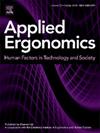Novel ergonomics indicator-based approach for evaluating a supplier organization's sustainable process performance
IF 3.4
2区 工程技术
Q2 ENGINEERING, INDUSTRIAL
引用次数: 0
Abstract
Ergonomics principles can be crucial in supplier audits by providing an effective framework and continuum ratings, moving beyond check-sheet based dichotomous rating. In contemporary supply chain management practices focal firms –which govern supply chains– are held accountable for product sourcing and transportation deficiencies. This study proposes a novel method for assessing the supplier organization's sustainability performance by integrating twenty-five ergonomics indicators (EIs) across economic, ecological, and social dimensions. Data from 38 Pakistani supplier organizations exporting products to Western firms were analyzed to develop an interval-scale-based evaluation scheme, and aggregated to form an organization's composite sustainable performance score. The results showed that the economic dimension was more frequently measured by the organizations compared to the ecological and social dimensions. Moreover, mapping these EIs onto Sustainable Development Goals (SDGs) demonstrates their relevance to SDGs broadly. A performance scorecard was also designed to assess suppliers' sustainability practices within the ergonomics paradigm, enabling organization-to-organization comparisons through visual representation. This approach supports focal firms in incorporating sustainable and resilient process performance into their supplier evaluations.
基于人机工程学指标的供应商可持续过程绩效评估新方法
通过提供有效的框架和连续评级,超越基于检查表的二分评级,人体工程学原理在供应商审核中至关重要。在当代供应链管理实践中,管理供应链的重点公司对产品采购和运输缺陷负责。本研究提出了一种新的方法,通过整合经济、生态和社会维度的25个人体工程学指标(ei)来评估供应商组织的可持续性绩效。分析了38个向西方公司出口产品的巴基斯坦供应商组织的数据,以制定基于间隔尺度的评估方案,并汇总形成一个组织的综合可持续绩效评分。结果表明,与生态和社会维度相比,组织更频繁地测量经济维度。此外,将这些环境影响评价与可持续发展目标(sdg)相关联,表明了它们与可持续发展目标的广泛相关性。还设计了一个绩效记分卡,以评估供应商在人体工程学范式下的可持续性实践,通过可视化表示实现组织与组织之间的比较。该方法支持重点公司将可持续和弹性过程绩效纳入其供应商评估。
本文章由计算机程序翻译,如有差异,请以英文原文为准。
求助全文
约1分钟内获得全文
求助全文
来源期刊

Applied Ergonomics
工程技术-工程:工业
CiteScore
7.50
自引率
9.40%
发文量
248
审稿时长
53 days
期刊介绍:
Applied Ergonomics is aimed at ergonomists and all those interested in applying ergonomics/human factors in the design, planning and management of technical and social systems at work or leisure. Readership is truly international with subscribers in over 50 countries. Professionals for whom Applied Ergonomics is of interest include: ergonomists, designers, industrial engineers, health and safety specialists, systems engineers, design engineers, organizational psychologists, occupational health specialists and human-computer interaction specialists.
 求助内容:
求助内容: 应助结果提醒方式:
应助结果提醒方式:


